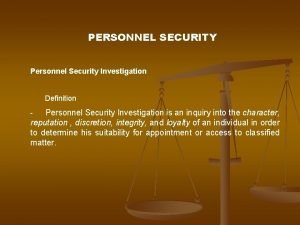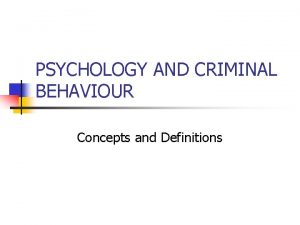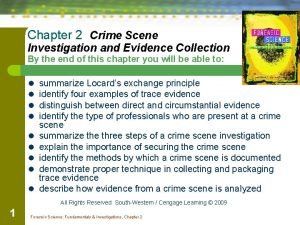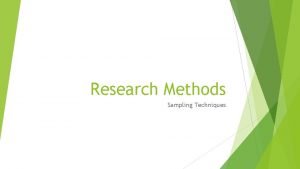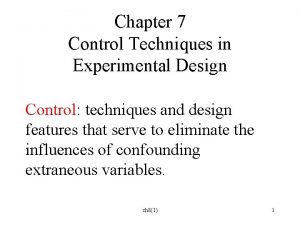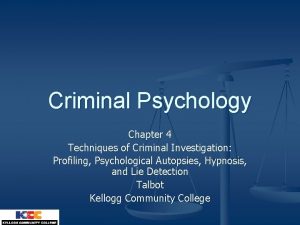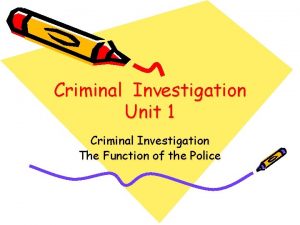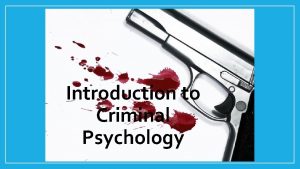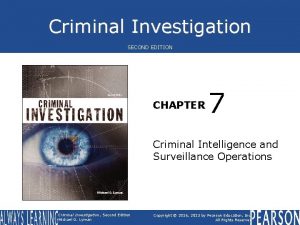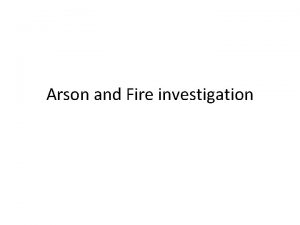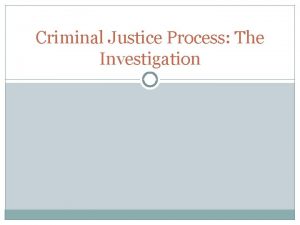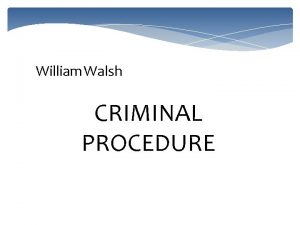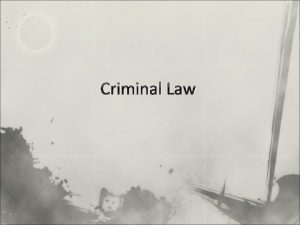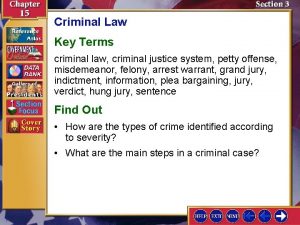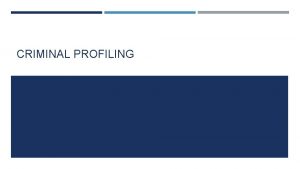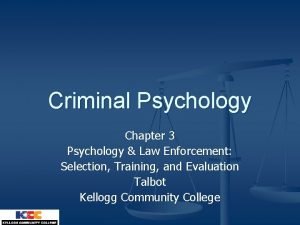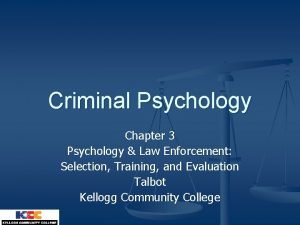Criminal Psychology Chapter 4 Techniques of Criminal Investigation













![n n e⋅quiv⋅o⋅cal /ɪˈkwɪvəkəl/ Show Spelled Pronunciation [i-kwiv-uh-kuhl] Show IPA Pronunciation –adjective 1. n n e⋅quiv⋅o⋅cal /ɪˈkwɪvəkəl/ Show Spelled Pronunciation [i-kwiv-uh-kuhl] Show IPA Pronunciation –adjective 1.](https://slidetodoc.com/presentation_image/1aab05795a4bdf1e92e4bab8646434c6/image-14.jpg)




- Slides: 18

Criminal Psychology Chapter 4 Techniques of Criminal Investigation: Profiling, Psychological Autopsies, Hypnosis, and Lie Detection Talbot Kellogg Community College

Profiling n Is it an appropriate topic for Forensic Psychology? n n What is Criminal Profiling? n n Is Clarice Starling typical? Maybe in Britain. It is an application of psychological principles to the legal field. How is it different from Psychological/Personality Profiles? n n PP attempts to typically identify problems or characteristics of one’s personality from information provided by the subject. CP is the process by which one applies & assesses information from a crime in order to determine possible characteristics of the perpetrator.


Psychological/ Personality Profile n n n n Minnesota Multiphasic Personality Inventory (MMPI - 2) High reliability and validity (LFK) Myers Briggs Personality Profile Di. SC Tests Colors Personality Test House-Tree-Person California Personality Inventory

Criminal Profile n n n No “one” agreed upon method. John Douglas Ohio v. Lowe “As a whole, the record reflects that Douglas’s opinion for the most part is based on the behavioral science of clinical psychology, an area in which he has no formal education, training or licensure… While we in no way trivialize the importance of his work in the field of crime detection, we do not find sufficient evidence… to qualify Douglas as an expert witness. ” n Science or Art?

Criminal Profiling Three approaches n Prediction of Individual Behaviors (CIA) Determining Common Characteristics – Developing a descriptive process for crime classification (Crime Classification Manual). Extracting Specific Characteristics (FBI) 1. 2. 3. 1. Modus Operandi – method/ mode of operation 1. 2. CHANGES in order to assist in the perpetrator’s efficiency. Signature – a reflection of the unique, personal aspects of the criminal act. 1. NEVER CHANGES – Part of why they commit the crime.

Signature or M. O. ? n n A bank robber requires all bank patrons and employees to remove their clothes prior to leaving. A bank robber requires all bank patrons and employees to remove their clothes. He then poses them and photographs them.

Criminal Profiling Three approaches n Prediction of Individual Behaviors (CIA) Determining Common Characteristics – Developing a descriptive process for crime classification (Crime Classification Manual). Extracting Specific Characteristics (FBI) 1. 2. 3. 1. Modus Operandi – method/ mode of operation 1. 2. Signature – a reflection of the unique, personal aspects of the criminal act. 1. 3. CHANGES in order to assist in the perpetrator’s efficiency. NEVER CHANGES – Part of why they commit the crime. Organized v. Disorganized

Organized v. Disorganized n Organized (nonsocial) Ted Bundy n n n Plan Use restraints Commit sexual acts with live victims Emphasize control over the victim Use a vehicle Disorganized (asocial) n n n Leave a weapon at the scene of the crime Reposition the dead body Perform sexual acts with the dead body Keep the dead body Try to depersonalize the body Not use a vehicle

Ted Bundy n n 1967 – Linda Healy 1969 – Parentage 1974 - Carol De. Ronch 1978 - 1979

Criminal Profiling Three approaches n Prediction of Individual Behaviors (CIA) Determining Common Characteristics – Developing a descriptive process for crime classification (Crime Classification Manual). Extracting Specific Characteristics (FBI) 1. 2. 3. 1. Modus Operandi – method/ mode of operation 1. 2. Signature – a reflection of the unique, personal aspects of the criminal act. 1. 3. 4. CHANGES in order to assist in the perpetrator’s efficiency. NEVER CHANGES – Part of why they commit the crime. Organized v. Disorganized Serial v. Spree v. Mass VICAP

Serial – Spree - Mass n n n Serial – Three or more separate events with a cooling-off period. Joseph Kallinger Spree – Killings at two or more locations with no emotional cooling-off period. Mass – More than three victims in one location and within one event. Charles Whitman

Psychological Autopsies n An investigative method used by psychologists or other social scientists to help determine the mode of death in equivocal cases.
![n n equivocal ɪˈkwɪvəkəl Show Spelled Pronunciation ikwivuhkuhl Show IPA Pronunciation adjective 1 n n e⋅quiv⋅o⋅cal /ɪˈkwɪvəkəl/ Show Spelled Pronunciation [i-kwiv-uh-kuhl] Show IPA Pronunciation –adjective 1.](https://slidetodoc.com/presentation_image/1aab05795a4bdf1e92e4bab8646434c6/image-14.jpg)
n n e⋅quiv⋅o⋅cal /ɪˈkwɪvəkəl/ Show Spelled Pronunciation [i-kwiv-uh-kuhl] Show IPA Pronunciation –adjective 1. allowing the possibility of several different meanings, as a word or phrase, esp. with intent to deceive or misguide; susceptible of double interpretation; deliberately ambiguous: an equivocal answer. 2. of doubtful nature or character; questionable; dubious; suspicious: aliens of equivocal loyalty. 3. of uncertain significance; not determined: an equivocal attitude.

Psychological Autopsies n n An investigative method used by psychologists or other social scientists to help determine the mode of death in equivocal cases (i. e. determine the mode of death in questionable cases). NASH classifications n n Natural Accidental Suicidal Homicidal

Psychological Autopsy n Victim n n Circumstances n n n 36 year old female Mother of 2 children (ages 4 and 7) Married to husband for 8 years Fire department called by husband. Husband claimed wife had been depressed for approximately 2 years and had been recently making suicidal comments. Wife’s body was found on a couch, face down. No note left. Problems? The results can be equivocal as well.

Hypnosis n n Definition: An altered state of consciousness characterized by narrowed attention and increased suggestibility. Hillside Strangler 1977 - 1978 n The case of Kenneth Bianchi n n n 10 women murdered, raped, tortured and strangled to death. Bodies found on hillsides northeast of Los Angeles. Under hypnosis displayed DID traits including an alter ego Steve Forensic expert in hypnosis cast doubt on this due to slight inconsistencies in his actions. Problems? n Hypnotic susceptibility?

Polygraphs n n Lie Detector? Measures Sympathetic Nervous System activation as an indicator of truth. n n n GSR Blood Pressure Heart Rate Respirations Control Question Technique Problems? n n n False Positive (Classification of truth tellers as liars) False Negatives (Classification of liars as truth tellers). Admissibility
 Criminal investigation lesson plans
Criminal investigation lesson plans Security investigation types
Security investigation types Define criminal psychiatry
Define criminal psychiatry Pyramid of crime
Pyramid of crime Act focused serial killer
Act focused serial killer History of criminal psychology
History of criminal psychology Polarization psychology
Polarization psychology Summarize locard's principle of exchange
Summarize locard's principle of exchange Fonction technique scooter
Fonction technique scooter What are the sampling methods in psychology
What are the sampling methods in psychology Counterbalancing
Counterbalancing Projective techniques in psychology
Projective techniques in psychology Qualitative research procedures
Qualitative research procedures Positive psychology ap psychology definition
Positive psychology ap psychology definition Social psychology ap psychology
Social psychology ap psychology Introspection method of psychology
Introspection method of psychology Social psychology definition psychology
Social psychology definition psychology Health psychology definition ap psychology
Health psychology definition ap psychology Vcaa extended investigation
Vcaa extended investigation

